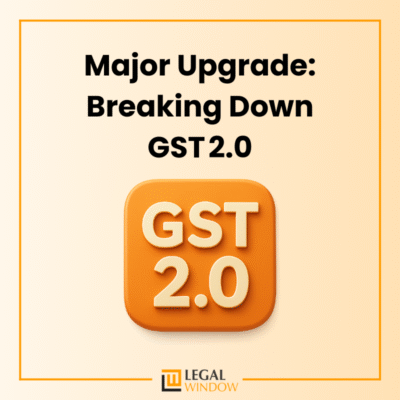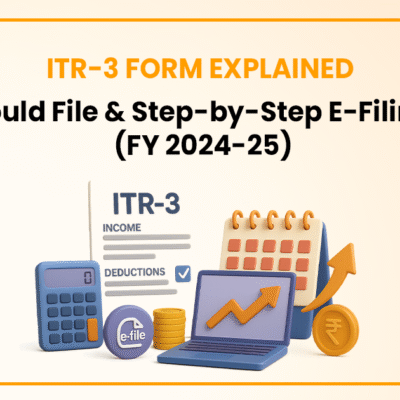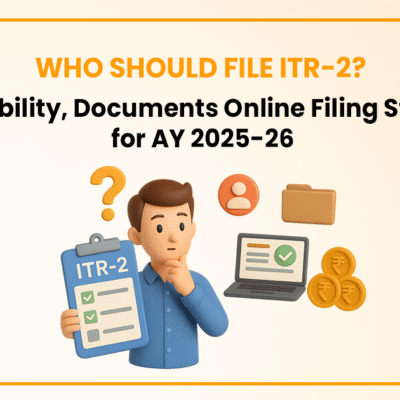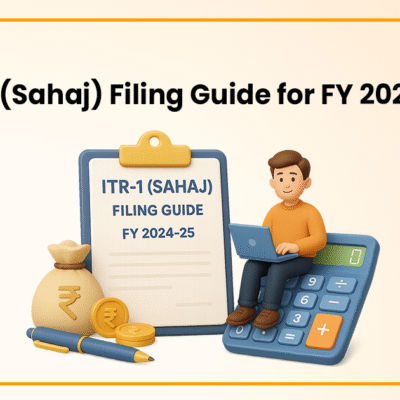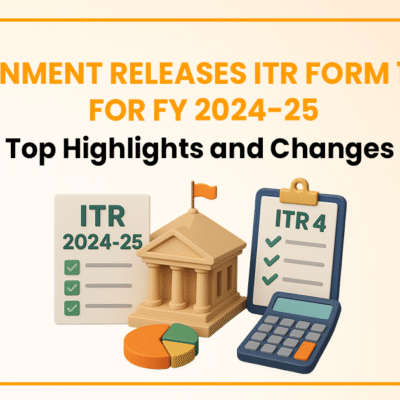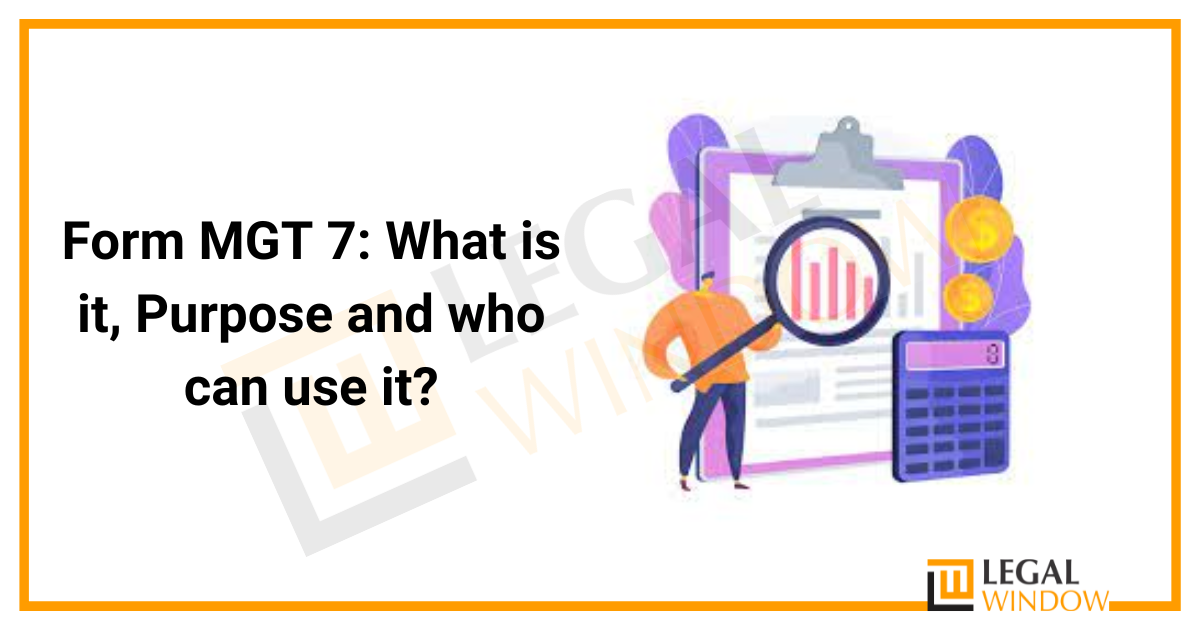
In the world of corporate governance and regulatory compliance, companies are required to submit various forms and reports to ensure transparency and accountability. One such form is Form MGT 7, which plays a crucial role in the documentation and disclosure of important information about a company's management and operations. In this article, we will delve into what this Form is, its purpose, and who can use it.
| Table of Content |
What is Form MGT 7?
Form MGT 7 is a crucial document that plays a significant role in the corporate world. It is a form prescribed by the Ministry of Corporate Affairs (MCA) in India under the Companies Act, 2013. MGT 7 is commonly known as the Annual Return, and it serves as a comprehensive record of a company's activities and financial information throughout the year.
Form MGT-7 is a statutory document that is required to be filed by every company incorporated under the Companies Act, 2013, or any previous company law. It serves as a tool for companies to disclose crucial information and provide a transparent account of their affairs to the stakeholders, including shareholders, regulators, and the general public. The form is required to be filed annually with the Registrar of Companies (RoC) within a specified time frame.
The main objective of Form MGT 7 is to provide transparency and accountability in corporate operations. It requires companies to disclose relevant information about their structure, operations, finances, and governance. By filing this form, companies fulfill their obligation to report to the government and shareholders, allowing them to make informed decisions based on accurate information.
Objective of Form MGT-7
The primary objectives of Form MGT-7 are as follows:
- Disclosure of Company Information: Form MGT-7 serves as a medium for companies to disclose essential information about their structure, financials, operations, and management. It includes details about the registered office, shareholders, directors, auditors, share capital, investments, loans, and advances, among other relevant information. By providing this information, the form ensures transparency and accountability in corporate functioning.
- Compliance with Statutory Requirements: Filing Form MGT-7 is a legal obligation for all companies registered under the Companies Act, 2013. By adhering to this requirement, companies demonstrate their commitment to compliance and adherence to the law. It helps in maintaining the integrity of corporate governance practices and provides a level playing field for all entities operating in the corporate sector.
- Stakeholder Communication: Form MGT-7 acts as a communication tool between the company and its stakeholders. Shareholders, creditors, employees, and other interested parties can access the filed annual returns to gain insights into the company's financial health, performance, and governance practices. This information enables stakeholders to make informed decisions, evaluate the company's prospects, and protect their interests.
- Assessment of Corporate Governance Practices: Form MGT-7 requires companies to disclose information related to their corporate governance practices, such as the composition of the board of directors, board committees, remuneration policies, related-party transactions, etc. This facilitates an evaluation of the company's adherence to sound governance principles and guidelines. It encourages companies to adopt best practices, improve transparency, and mitigate the risks associated with corporate misconduct.
- Regulatory Oversight and Enforcement: Form MGT-7 serves as a crucial document for regulatory authorities, primarily the RoC and the Ministry of Corporate Affairs (MCA). It helps these bodies in monitoring and enforcing compliance with the provisions of the Companies Act, 2013. By analyzing the filed annual returns, regulatory authorities can identify irregularities, non-compliance, or any fraudulent activities in the functioning of the company. This enables them to take appropriate action to safeguard the interests of stakeholders and maintain the integrity of the corporate sector.
Benefits of Filing Form MGT-7
Benefits of filing Form MGT 7 are as follows:
- Compliance with Legal Requirements: Filing Form MGT-7 ensures compliance with the provisions of the Companies Act, 2013. It demonstrates the company's commitment to good corporate governance practices and enhances its credibility among stakeholders, including shareholders, lenders, and regulatory authorities.
- Transparent Corporate Governance: Form MGT-7 provides a detailed snapshot of the company's corporate structure, including the composition of the board of directors, details of key management personnel, and changes in shareholding patterns. This transparency helps in building trust among shareholders and potential investors.
- Complete Financial Information: The form requires companies to disclose their financial statements, including the balance sheet, profit and loss account, and cash flow statement. By filing Form MGT-7, companies provide stakeholders with a comprehensive view of their financial performance, enabling informed decision-making.
- Updated Company Information: Form MGT-7 necessitates the disclosure of essential information, such as the registered office address, details of subsidiaries, shares held by the directors, and any changes in the company's constitution during the year. This updated information facilitates easy access to accurate data, ensuring that stakeholders are well-informed.
- Enhanced Corporate Social Responsibility (CSR) Reporting: Companies meeting certain thresholds are required to spend a specific percentage of their profits on CSR activities. Form MGT-7 includes reporting on CSR initiatives, enabling companies to showcase their social impact and contributions to society.
- Protection of Shareholder Rights: Form MGT-7 requires companies to disclose details of share transfers, including the transferor and transferee. This ensures the protection of shareholder rights and helps identify any irregularities or unauthorized transfers, promoting fair practices and preventing fraudulent activities.
- Avoidance of Penalties and Legal Consequences: Non-compliance with the filing of Form MGT-7 can attract penalties and legal consequences. By adhering to the filing deadlines and accurately submitting the required information, companies can avoid unnecessary penalties and potential legal challenges.
Key components of Form MGT 7
Form MGT 7 comprises several sections and requires specific information to be filled in. Some of the crucial components include:
- Basic Details: The form begins by capturing the basic information of the company, including its name, registered office address, Corporate Identity Number (CIN), and the type of company (public, private, etc.).
- Financial Information: Form MGT 7 requires companies to disclose their financial statements, including the balance sheet, profit and loss account, and cash flow statement. This information provides insights into the company's financial performance and stability.
- Shareholding Pattern: Companies need to provide details about their share capital, including the authorized and issued share capital, as well as the composition of shareholders, their categories, and the number of shares held by each category.
- Changes in Directors and Key Managerial Personnel: Any changes in the board of directors or key managerial personnel during the year, such as appointments, resignations, or removals, must be disclosed in this section.
- Meetings of the Board and its Committees: The form requires companies to provide information about board meetings, committee meetings, and the attendance of directors. This ensures transparency in the decision-making process and corporate governance.
- Disclosure of Related Party Transactions: Companies are obligated to disclose any transactions with related parties, including directors, key managerial personnel, and their relatives. This section ensures transparency and prevents conflicts of interest.
- Compliance with provisions of the Companies Act: Form MGT 7 includes a checklist of statutory compliances that companies need to confirm they have adhered to during the financial year. This covers areas such as annual general meetings, filing of financial statements, appointment of auditors, and compliance with other legal requirements.
Who should file Form MGT-7?
The filing of Form MGT-7 is mandatory for the following types of companies:
- Every Company: Every company incorporated under the Companies Act, 2013, regardless of its type or size, is required to file Form annually. This includes Private Limited Companies, Public Limited Companies, One Person Companies, and other types of companies.
- Small Companies: Even small companies, which are defined as those meeting specific criteria related to turnover, net worth, and capital, must file Form. The Companies Act provides certain relaxations for small companies in terms of financial statements, but they are still required to file the annual return.
- Companies having a Share Capital: All companies having a share capital, irrespective of the amount, are obligated to file Form MGT-7. This includes companies with minimal share capital as well as those with substantial capital investments.
- Companies without a Share Capital: Even companies that do not have a share capital, such as section 8 companies (non-profit organizations) or companies limited by guarantee, are required to file Form MGT-7. These companies may not have shareholders, but they still have members or guarantors, and their information needs to be disclosed in the annual return.
It is essential for companies to file Form MGT-7 within the stipulated time frame to comply with legal requirements. The due date for filing the annual return is within 60 days from the conclusion of the company's AGM. In case the AGM is not held, the due date is within 60 days from the date on which the AGM should have been held. Failure to file Form on time may attract penalties and can have legal repercussions.
Documents Required for Filing Form MGT 7
The following are the key documents required to file Form MGT-7:
- Financial Statements: Companies must attach their financial statements, including the balance sheet, profit and loss account, cash flow statement, and notes to accounts, with the form. These documents should be audited and prepared in accordance with the applicable accounting standards.
- Shareholding Pattern: The shareholding pattern indicates the distribution of shares among various shareholders. It includes details such as the names, addresses, and shareholding percentages of individual shareholders and the category of shares held by them.
- Details of Directors and Key Managerial Personnel (KMP): Companies need to provide information about their directors and KMPs. This includes details like their names, addresses, DIN (Director Identification Number), and their roles within the organization.
- Meetings of the Board of Directors: The company must furnish details of the board meetings held during the financial year, including the dates, attendance of directors, and the minutes of these meetings.
- General Meetings: The annual general meetings (AGMs) held during the financial year should be documented. This includes information about the dates, agenda, resolutions passed, and attendance of shareholders at these meetings.
- Compliance with Corporate Governance Norms: Companies need to disclose their compliance with various corporate governance requirements as prescribed by the Companies Act, 2013. This includes providing details of board committees, related party transactions, CEO/CFO certifications, etc.
- Register of Members, Debenture Holders, and other Statutory Registers: The company must maintain various statutory registers as required by law. These registers should be up to date and included with the filing of Form MGT-7. Examples of such registers include the Register of Members, Register of Debenture Holders, Register of Contracts or Arrangements, etc.
- Annual Return Certification: Form MGT-8, which is a certification by a company secretary or a chartered accountant, should be attached with Form MGT-7. This certification validates the correctness and completeness of the information provided in the annual return.
- Other Supporting Documents: Companies should include any other relevant documents as required by the Registrar of Companies (RoC). These may include resolutions, agreements, or disclosures made during the financial year.
Steps to File Form MGT-7
The following are the steps to file Form MGT 7:
- Step 1: Obtain the Required Information: Before proceeding with the filing of Form MGT-7, gather the necessary information and documents. This includes details about the company's shareholders, directors, financial statements, share capital, and other relevant information. Ensure that all the information is accurate and up to date.
- Step 2: Download the Form: Visit the official website of the Ministry of Corporate Affairs (MCA) or the respective Registrar of Companies (RoC) to download Form MGT-7. The form is available in a fillable PDF format, making it convenient for electronic filing.
- Step 3: Fill in the Details: Carefully fill in all the required details in Form MGT-7. The form consists of various sections, and each section seeks specific information. Provide accurate and up-to-date information to ensure compliance with the legal requirements. The sections of Form MGT-7 include:
- General Details: Provide general information about the company, such as its name, registered office address, CIN (Corporate Identification Number), and email address.
- Share Capital: Furnish details regarding the company's share capital, such as the authorized capital, issued capital, paid-up capital, and the changes, if any, during the financial year.
- List of Shareholders: Provide a detailed list of shareholders, along with their names, addresses, and shareholdings.
- Directors and Key Managerial Personnel (KMP): Mention the names, DIN (Director Identification Number), addresses, and other relevant details of the directors and KMP of the company.
- Subsidiary Companies: If the company has any subsidiaries, provide the necessary details, including the names and CINs of such subsidiary companies.
- Financial Statements: Enter the financial details, such as the balance sheet, profit and loss account, and cash flow statement, for the financial year.
These information’s are required for filing Form MGT 7.
- Step 4: Verification and Signing: After filling in all the required details, verify the information provided in Form MGT-7. Ensure that the details are accurate, complete, and properly cross-checked. Once you have verified the form, affix the digital signatures of the authorized signatories, such as the director or company secretary.
- Step 5: Submit the Form: Once the form is duly filled, verified, and signed, it is ready for submission. Visit the MCA portal or the relevant RoC portal and upload the Form MGT-7. Pay the requisite filing fee as prescribed by the MCA or RoC for the submission of the form.
- Step 6: Acknowledgment and Recordkeeping: After successful submission, the MCA or RoC will generate an acknowledgment receipt. Download and save the acknowledgment receipt for future reference. It serves as proof of submission of Form MGT-7. Additionally, maintain a copy of the filed Form MGT-7 along with other relevant documents for recordkeeping purposes.
Filing and Due Date
Companies are required to file Form MGT 7 within 60 days from the conclusion of the Annual General Meeting (AGM) of the company. The AGM must be held within six months from the end of the financial year. It is important to note that late filing or non-filing of Form can lead to penalties and other legal consequences.
Conclusion
In conclusion, Form MGT 7 is a critical document that provides a comprehensive overview of a company's management and operations. Its purpose is to enhance transparency, accountability, and corporate governance practices. All companies incorporated under the Companies Act, 2013 are obligated to file Form annually, ensuring compliance with the prescribed timelines and requirements. By fulfilling this requirement, companies demonstrate their commitment to good governance and provide stakeholders with the necessary information to make informed decisions.
We have attempted to include all pertinent information in this Article. However, for further information on this and other forms, please contact Legal Window at [email protected] or phone +91-72407 51000.
CS Urvashi Jain is an associate member of the Institute of Company Secretaries of India. Her expertise, inter-alia, is in regulatory approvals, licenses, registrations for any organization set up in India. She posse’s good exposure to compliance management system, legal due diligence, drafting and vetting of various legal agreements. She has good command in drafting manuals, blogs, guides, interpretations and providing opinions on the different core areas of companies act, intellectual properties and taxation.
Categories
- Agreement Drafting (23)
- Annual Compliance (13)
- Change in Business (37)
- Company Law (150)
- Compliance (90)
- Digital Banking (3)
- Drug License (4)
- FEMA (17)
- Finance Company (42)
- Foreign Taxation (9)
- FSSAI License/Registration (15)
- GST (124)
- Hallmark Registration (1)
- Income Tax (214)
- Latest News (36)
- Miscellaneous (170)
- NBFC Registration (8)
- NGO (18)
- SEBI Registration (6)
- Section 8 Company (10)
- Start and manage a business (27)
- Startup/ Registration (134)
- Trademark Registration/IPR (48)
Recent Posts
- Major Upgrade: Breaking Down GST 2.0 September 15, 2025
- New Income Tax Bill 2025 August 27, 2025
- ITR-3 Form Explained: Who Should File & Step-by-Step E-Filing Guide (FY 2024-25) June 25, 2025
All Website Tags
About us
LegalWindow.in is a professional technology driven platform of multidisciplined experts like CA/CS/Lawyers spanning with an aim to provide concrete solution to individuals, start-ups and other business organisation by maximising their growth at an affordable cost.


